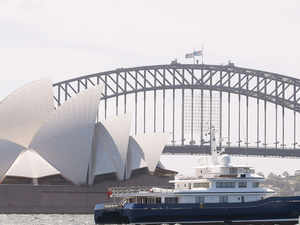The
secret to Australia avoiding recession: Mass immigration from India,
China
By Jason Scott and Michael Heath

“Australia’s immigration policy has given it an advantage over other developed nations in creating demand, consumption and employment,” said an expert.
Australia is standing firm amid growing calls for immigration
curbs, even as the U.S. and Europe succumb to rising populism. It has little
choice if it’s to continue a period of record economic expansion.
A flood of arrivals that’s swelled the
population by 50 percent over the past three decades has underpinned economic
growth and allowed a succession of governments to boast of avoiding recession
since 1991. Populists are blaming immigrants for over-burdened infrastructure,
soaring housing prices and low wage growth.
Australia’s former Prime Minister Tony Abbott,
now on the government’s backbench, is among those saying “enough.” He wants to
slash the annual allowance to 110,000 migrants from 190,000, a move the
government says could shrink its coffers by as much as A$5 billion ($3.9
billion) over four years. Anti-multiculturalism senator Pauline Hanson is
calling for zero net migration.
Introducing such curbs in Australia, which has
one of the fastest-growing populations in the developed world, could derail
economic growth that’s already lingering below its 10-year average.

“Australia’s immigration policy has given it an
advantage over other developed nations in creating demand, consumption and
employment,” said Su-Lin Ong, Royal Bank of Canada’s head of Australian
economic and fixed-income strategy. “It’s the challenge for politicians to
rationally, clearly explain why it’s beneficial and important for voters not to
be swayed by populist thinking. That’s clearly easier said than done.”
Governments from the U.S. to the U.K to Europe have clamped
down on immigration as voters are increasingly drawn to populist parties
blaming foreigners for widening social and economic inequality. Australia has
taken the opposite route: it welcomed almost 184,000 new arrivals in fiscal
2017.
Reserve Bank of Australia chief Philip Lowe last
year said population growth was flattering economic data. Indeed, digging
beneath the past quarter century’s unbroken gross domestic product record
reveals a somewhat bleaker picture: on a GDP per person basis, the growth in
economic output was zero at the end of last year and the weakest since the
third quarter of 2016.
An accelerating population makes it less likely
the nation will slip into a recession -- technically defined as two straight
quarters of economic contraction -- said Gareth Aird, chief economist at
Commonwealth Bank of Australia.

“So if you’ve got strong population growth -- whether or not
it’s driven by immigration -- then it’s harder to go backwards in an output
sense. But if you look at the economy on a per capita basis, we’ve had a couple
of recessions over that period.”
Population growth is also weighing on
unemployment. Despite the creation of 400,000 new roles in 2017, the jobless
rate hovered around 5.5 percent for most of the previous year. That’s largely
because more people are looking for work: the the labor force participation
rate is near a seven-year high. The RBA is reluctant to lift interest rates
from a record low until the jobless rate is nearer 5 percent -- its estimated
full employment target.
Australia’s so-called points system for assessing
potential migrants sees skilled workers ranked by their need, and they must
also pass health and character tests. Those becoming citizens must first pass
an English-language quiz on the nation’s constitution, history and values. India
is the biggest source of skilled migrants, comprising 21 percent in fiscal
2017, followed by China on 15 percent and the U.K. with 9 percent.
Big Fans
Before
he became U.K. Foreign Minister, Boris Johnson said during the Brexit campaign
that his nation should adopt a “genuine Australian-style points system.”
President Trump’s administration has also hailed the process for its stringent
vetting of candidates.
But even with such a strict system, local opponents
say Australia is allowing in too many migrants. While its 25 million people
dwell on a continent that’s 50 percent larger than Europe, an arid and dry
climate makes most of the land uninhabitable. A government-commissioned report
this month said another 11.8 million will arrive in the next 30 years, with the
vast majority going to the nation’s four largest cities -- Sydney, Melbourne,
Brisbane and Perth.
Vote Winner
Populist
politicians “think this issue is a winner because they’ve seen it win before,”
said David Burchell, a political analyst at the University of Western Sydney.
“They’re looking around the world, such as the U.S. and Europe, and seeing that
cutting immigration numbers is a popular narrative.”
Just over half of Australians think the total
number of migrants coming to Australia each year is either ‘about right’ or
‘too low’, according to a Lowy Institute survey published last June. Four in
ten said the number was too high .
For now, Prime Minister Malcolm Turnbull is standing firm on
immigration, signaling he won’t adjust a policy that added 1.6 percent to the
nation’s size in fiscal 2017, compared with the developed world average of 0.7
percent in 2016.
Former New South Wales premier Bob Carr, who in
2000 said Sydney was “full,” used an Australian Broadcasting Corp. interview on
Monday to again call for less immigration, saying it might “encourage
Australians to find other ways of driving a contemporary economy.”
Demands for a rethink of policy are likely to
mount, according to Paul Williams, a political analyst at Brisbane’s Griffith
University.
“There’s more noise around this issue than we’ve
seen in years,” he said. “That’s coming from fringe politicians now, but
there’s no doubt a lot of Australians want the major parties to start having a
conversation about immigration.”
Read more at:
//economictimes.indiatimes.com/articleshow/63281537.cms?utm_source=contentofinterest&utm_medium=text&utm_campaign=cppst
//economictimes.indiatimes.com/articleshow/63281537.cms?utm_source=contentofinterest&utm_medium=text&utm_campaign=cppst
No comments:
Post a Comment